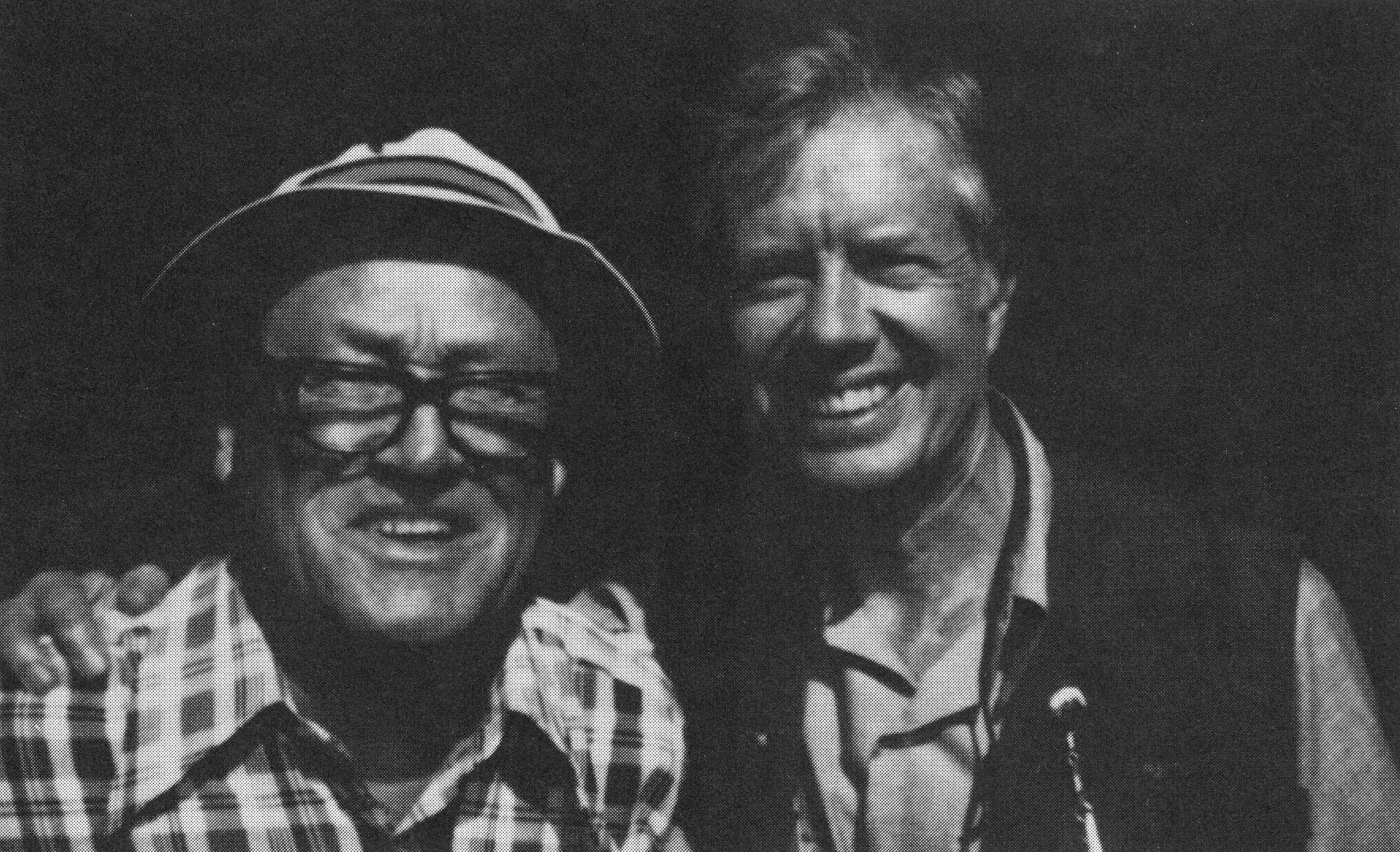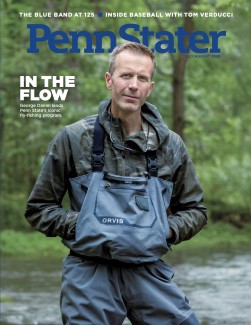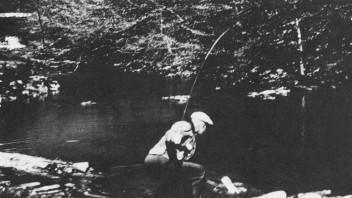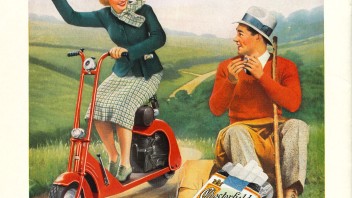Alumni aren’t the only ones who yearn for Happy Valley. Presidents of the United States have also found the area around University Park—especially the trout streams—to be one where rest, tranquility and, most importantly, seclusion are not only possible but assured.
Jimmy Carter fished here—in Spruce Creek—seven times in 1980, most recently on the weekend right after the election when he needed a quiet place to recuperate from the disaster.

Dwight Eisenhower also fished in Spruce Creek during the years he lived at the White House and brother Milton occupied the Penn State president’s mansion. And though it has not been substantiated, it is almost a certainty that a third president—William Howard Taft—fished here too, not during his White House tenure but in 1919 as a guest of Penn State President Edwin Sparks at the Spruce Creek Rod and Gun Club. An angler himself, Sparks was a charter member of the club and often entertained legislators, trustees, and other visiting dignitaries there.
So what’s the big attraction to this little body of water that meanders just a few miles southwest of Penn State’s main campus? Those who know say it’s about the best trout stream east of the Mississippi. But any fisherman worth his hackle flies knows that the real drawing card here is a man who graduated from Penn State, spent nearly 38 years on its faculty, and has gained a reputation as one of the best fishermen and fly-tyers in the world. He is George Harvey ’35 Agr, who organized the first angling and fly-tying classes in the U.S., in 1934; developed and taught the first accredited college-level angling course, at Penn State in 1947; and has taught more people—some 35,000—to tie flies than anyone on record.
George has given 200 lectures and scores of clinics and extension courses on angling throughout Pennsylvania and other states. He also has written or been the subject of dozens of articles in fishing magazines and wrote the entry on fly casting for Collier’s Encyclopedia. His recognitions include the Federation of Fly Fishers 1978 national award for his contributions to the sport and the coveted “Order of the Hat” from the Harrisburg Fly Fishers Club for his conservation efforts.
Presidents Carter and Eisenhower learned the fly-tying art from him as well as the finer points of casting, and Taft might well have done the same, since George caught his first trout in 1916 at the age of 6.
“I caught my first fish earlier than that, though,” he said, “when I was 3. Only that was on bait. The trout was on a fly.”
Born at DuBois, Pa., on Nov. 14, 1911, George was the second of three children whose father was an avid fisherman but, for a living, operated a perpetual-care cemetery. Helping his dad care for the trees and shrubs there convinced George that he should major in ornamental horticulture at Penn State, but he was a little short on cash.
“I started school in the depths of the Depression, 1931,” he said, “so I had to hold down four jobs at once to pay my way.”
Pledging Phi Kappa Sigma fraternity, he tended its coal furnace and also those of the neighboring houses along East Beaver Avenue—SAE, Triangle, Kappa Sigma, and DU.
“I had to stoke them up at five in the morning, run back from campus at noon to stoke them again, and then bank them all at midnight,” he recalled. “And I got fifteen dollars a month from each house for doing it.”
He also served the fraternities as waiter, dishwasher, and peeler of potatoes, but still managed to find time to captain the varsity track and cross-country teams; participate in intramural boxing, wrestling, and soccer; and, of course, to fish.
In an article last year in Rod and Reel magazine, George told how the fishing course he developed as an undergraduate came about. It seems that Dean of Agriculture Ralph L. Watts 1890, 1899 MS Agr offered to take any ag student trout fishing, and George took him up on it for Opening Day. The pair drove to Spring Creek, where George asked to be dropped off upstream and would fish down to the dean’s location.
When Watts saw that George was planning to use flies, he said, “This early in the season you don’t fish with flies. The water’s too high. Bait’s much better,” and he offered some to George. But the young man declined, saying he’d give the flies a try. What the dean didn’t know was that the old-time anglers around DuBois had always counted on George to fill their limits for them, in case they failed on their own.
That morning on Spring Creek it didn’t take George long to fill his creel and the game pocket in his coat with what was then the limit, 20 trout. (Today’s Pennsylvania limit ranges from three to eight depending upon the season.)
When he rejoined the dean, he found Watts displaying four brook trout and gloating, “I got four dandies, son. How’d you do?” In response, George emptied the fly-caught contents of his creel and coat pocket onto the stream bank.” Well, I’ll be joe-dogged,” said the dean. “What nice fish!”
Soon George was teaching fly tying to the dean and other faculty members. Then, with the state fish commissioner being a friend of Watts’, it came as no surprise that in 1934, when Pennsylvania established the first regulated fishing area in the country—Fisherman’s Paradise on Spring Creek—George was invited to teach fly-tying classes there. Later, in 1947, he developed them into a full-fledged college course at Penn State, covering angling and casting as well as fly-tying techniques.
Upon graduating in 1935 with a B.S. in horticulture, George was hired by Penn State to start up physical education classes and teach dendrology (identification of trees and shrubs) at its new Mont Alto Forestry School. He stayed there until 1942, when the campus was closed “for the duration” and he was moved back to State College to give phys ed training to military officers stationed at Penn State. He also coached the Nittany Lion track team for the three years Coach Chick Werner was in the service. Then, after the war, George helped Nick Thiel ’38 with the men’s required phys ed program, until taking over the head job himself from 1958 to 1972, when he retired.
Early in his Penn State career, George married his childhood sweetheart, Helen, a registered nurse who headed outpatient services at Ritenour Health Center for 17 years. They had one child, Sue, who at age 3 tied her first fly and as a teen caught a trout more than 20 inches long. A 1964 Penn State graduate, Sue is now Mrs. Kenneth Keller of Hagerstown, Md., and still owns a fine English-made rod and reel that Dwight Eisenhower gave her on one of his many trips to State College in the 1950s.
“Ike was already a good fly fisherman when I met him,” George said, “but Milton never quite got the hang of it. Jimmy Carter, on the other hand, will be better than Ike—in the top five percent in a couple more years—mainly because he wants to learn everything about it, and he catches on quickly. Rosalynn is also good, but Amy’s not.”
After one Spruce Creek outing last fall, George gave both Jimmy and Rosalynn shadow-box displays of his flies and received thank-you letters from each, with Jimmy writing (in September):
Again, we really enjoyed being with you for another all-too-brief visit to Spruce Creek. The mounted display of your flies is a work of art, and I have already hung them in my private White House study, where I hope they will remain for another 4 ½ years! Rosalynn is thrilled with the box and flies you gave her.
We are planning for you and Mrs. Harvey to come spend the night with us. We’ll pick out a mutually convenient date.
Your friend,
Jimmy Carter
P.S. – Send me another copy of your booklet (Techniques of Fly Tying and Trout Fishing).
The Harveys and Carters did make a date—at Camp David the weekend before Thanksgiving—where George gave fly-tying lessons to about 30 presidential friends, including Secretary of the Interior Cecil Andrus. Included on the guest list were farmer Wayne Harpster and his wife of Pennsylvania Furnace, who had hosted the Carters on all their Spruce Creek visits last year, just as Wayne’s late father Bob had done for Ike in the 1950s.
Also at Camp David was Belleville chicken farmer Buck Metz, the world’s leading producer of hackle, the feather pelts used in 99% of all fishing flies. It was George who talked the 39-year-old Cornell graduate into raising Blue Andalusians, Barbed Plymouth Rocks, and Old English Gamecocks solely for their neck feathers as a sideline to the mammoth meat and egg business he engages in with his brother John and their father and uncle. The latter are both Penn Staters: Bob Metz ’37 Lib, who managed the cross-country team when George was captain, and his brother Harry Metz ’40 Sci.
Using Metz hackles, an assortment of duck and partridge feathers, and various animal furs from the vast collection in his fly-tying room, George ties several dozen flies every morning before breakfast. “How long will a fly last? Well,” he says, “you might catch 100 fish with it or you might lose it in a tree trunk the first time you cast it.”
Writing about George in a 1978 Sports Afield magazine, Larry Madison ’36 Lib attributed the fishing success of his former intramural boxing opponent to not only his equipment and his casting ability, but also to the original “Harvey leader,” which he cuts with his teeth to change flies in midstream and keep the fish jumping into his creel.
In his 69 years, George has fished every stream in Pennsylvania and most of those in states as far west as Idaho and in Canada north to James Bay and east to Nova Scotia. Since retiring, he and Helen have spent every winter in Florida, fishing on Lake Placid from early December until returning to State College in time for Opening Day in mid-April.
“I have no favorite fishing spots,” he says. “I like all the mountain streams around here—and there are 50 within 50 miles of State College—although I enjoy Spruce Creek about as well as any. Spring Creek used to be the best on the East, until it got polluted.”

a few tips from George, who says, "She's a natural fisherman!"
The biggest trout he has ever caught was a 28 ½-inch brown, taken from Bald Eagle Creek near Curtin. The Pennsylvania record of 34 inches, though, is held by one of his former students, Joe Humphreys ’57 H&HD, ’63 MEd Edu, who now teaches the Penn State fly-tying course originated by Geoge. His catch was a brown trout from Fishing Creek near Mill Hall.
Although he has gone deep-sea fishing on occasion, George is not enthusiastic about it, saying it requires little skill (“It’s mostly trolling!”) and is too tiring. “The fish are too big. When you hook one, you have to play it for two hours. That’s work, not pleasure.”
Fly fishing for trout, on the other hand, is the most challenging, he feels. “It’s you against the fish. You do it alone. And you can’t completely master the sport.”
It also breeds conservation, since the thrill for most fly fishermen is in the hunt, and catches, for the most part, are set free.
Right now George and Helen are catching bass on Lake Placid, and this spring, on their way home to Pennsylvania, they’ll be stopping off in Georgia to fish a stream or two near Plains. “Jimmy’s going to call us in Florida to set up a date,” George said, “and then we’re expecting to see a lot of him and Rosalynn at Spruce Creek this year.”
The question now is, will Ronald Reagan want to learn fly tying too in the trout-fishing capital of the East?




